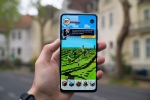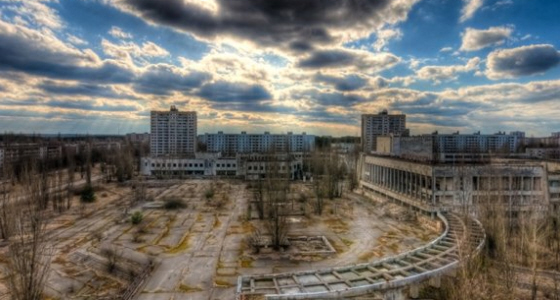
© Words Piers Hernu
The Big Wheel was to be the pride of the city. Standing 120 feet tall, with twenty bright yellow carriages, it was a gift from the Soviet authorities to the children of the 50,000 or so loyal citizens of Pripyat, a city built nine years earlier in 1977 to house the workers of the new Chernobyl Nuclear Power Plant. The grand opening was planned for May 1st an annual holiday throughout the communist Soviet Union and traditionally a day of fun and festivities. But the Big Wheel never turned. Five days before it’s planned opening, at 1.23am on the morning of April 26th 1986, a massive explosion a mere 3kms away, blew Chernobyl’s Reactor Four’s 3,000 ton reinforced steel lid to smithereens, spewing vast clouds of lethal radioactive debris into the surrounding atmosphere. By May 1st Pripyat was deserted, its inhabitants forcefully and 'temporarily' evacuated – the were never to return.
Today Pripyat remains almost totally deserted and will remain so for hundreds of years to come, rendered completely uninhabitable by levels of radiation which are unsurviveable. Almost totally deserted because today, some eighteen years after the disaster, FHM stands in silence gazing up at the rusting wheel. It stands there defiant, a chilling monument to the dangers of Nuclear energy; but most of all, it stands there as a heartbreaking monument to the children of Pripyat who never got to ride their Big Wheel - many of whom are no longer with us today.
As Anto, the photographer, and I collect our luggage at Kiev airport we both admit to feeling somewhat nervous. This stems not from fears of falling foul of the KGB or even radiation but from the fear that in five days time we may well be returning home without a story. The USSR may have dissolved and Ukraine may be an independent democracy but there is still plenty of old Soviet suspicion, bureaucracy and a heavy reliance on contacts to get anything done. Our only contact is Timur Dorofeyev, editor of Ukraine FHM who has emailed me that he is “extremely much confident” that he can gain us access to one of the most heavily guarded places in the world. I remain extremely much not very confident at all...
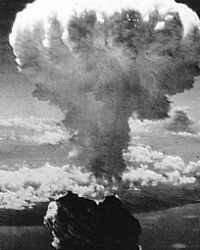 In 1945 Nagasaki and Hiroshima taught the world the destructive power of the Atomic Bomb. In 1986 Chernobyl taught the world the danger of nuclear power. In 2001 9/11 taught the world that nowhere is safe from terrorist attack. Combine these horrific incidents in any way you like and it is clear that today the world faces the very real possiblity of millions dead and whole countries rendered uninhabitable by radiation.
In 1945 Nagasaki and Hiroshima taught the world the destructive power of the Atomic Bomb. In 1986 Chernobyl taught the world the danger of nuclear power. In 2001 9/11 taught the world that nowhere is safe from terrorist attack. Combine these horrific incidents in any way you like and it is clear that today the world faces the very real possiblity of millions dead and whole countries rendered uninhabitable by radiation.In October of last year, with growing fears of “dirty” nuclear bombs and terrorist attacks on any of the 400 or so nuclear reactors around the world, a team of U.S. miltary experts visited Chernobyl to learn how to deal with the aftermath of a nuclear incident. “In the U.S. we unfortunately may need to react to events similar to those experienced by you in 1986,” explained Brigadier General Douglas Moore to the press, “especially now when all our nuclear facilities are subject to potential threat of terrorist attack.” With the threat of “dirty bombs” recently hitting the headlines over here, FHM decided it was time to visit Chernobyl to try and see for itself the horrors of a nuclear incident - whether unleashed by accident or by terrorists themselves.
Four days after our arrival we’ve met a couple of Ukraine’s leading experts on Chernobyl but the nearest we’ve got to visiting the place is the museum in Kiev. That evening Timur receives a welcome phone call: tomorrow morning at 7.30am he, Anto and I are to liase with Anna Udovichenko from the United Nations who has somehow secured permission to visit “The Exclusion Zone”.
Early the next morning the four of us head north in FHM’s hire car and two hours later, we pass our first sign for Chernobyl. As we do so Anto and I are forced to admit we are feeling considerably more nervous than before.
Radiation is a strange phenomena and it’s effects on the human body remain something of a mystery even today. Radiobiology being a relatively new, complicated and rare science, scientists simply do not have enough data to predict with any degree of certainty what will and will not happen in any given situation. Opinions vary wildly as to what is and isn’t a safe dose and how long that dose may be safe for. To cut the crap - Anto and I have no fucking idea what we’re letting ourselves in for and nor do the 'experts'.
The road to Chernobyl is understandably a quiet one. Eventually we turn a corner to be greeted by a heavily guarded checkpoint. “This is the beginning of the Exclusion Zone,” explains Anna, “hand me your passports.” Not having been told to bring it, mine is sitting back at the hotel. Scowls, cross words, urgent phone calls and after an extremely tense hour and a half, Anna recieves a call saying that Ukraine’s KGB have run a check on the foolish British journalist and he can continue into the Exclusion Zone provided he’s accompanied at all times.
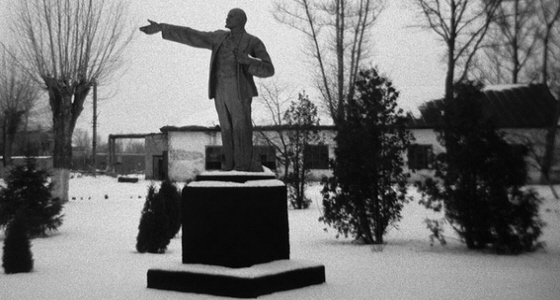
“There are many wolves here,” explains Yuri our guide who squeezes into the back of our car at the checkpoint, “wild boar too.” We speed past wild meadows and untamed forests and catch our first glimpse of abandoned homes drowning in a sea of greenery. Mother Nature is quick to reclaim what’s hers and it makes for disturbing viewing.
Five minutes later we enter the town of Chernobyl itself, some 18kms from the power plant and are surprised to see a few cars and people wandering about. “These are people who still work decontaminating the power plant,” explains Yuri, “here there is little radiation.” And with that he pulls a geiger counter out of his pocket. “See – only ten microroentgens that’s probably less than London!”
We pull over outside a monument which was made and unveiled on the 10th anniversary of the disaster in 1996 by local firefighters as a tribute to their colleagues who died. “To those men who died saving the world” it says simply and in many ways it is an accurate description. Two reactor crew were killed instantly by the explosion and 29 firemen died within days from massive doses of radiation. A further 209 workers were treated for acute radiation poisoning as the crippled reactor released an estimated 300 times the radioctivity released by the bombing of Hiroshima and Nagasaki in a huge cloud which, blown by the wind, was to contaminate every European country except for Spain, Portugal and Malta. In the UK alone some three million sheep and cattle were declared unfit for sale due to the radioactive fallout. Had it not been for the selfless efforts of the thousands of firemen, miners, helicopter pilots and construction workers who managed to contain the reactor fire in ten torrid days, the world today would be a very different place. “Their efforts ensured that only 5% of radioactivity was released from Reactor Four,” explained Alexandra …..the current Head Of Nuclear Safety at Chernobyl when we met him the day before in nearby Slavutich, “If it weren’t for them Ukraine, Poland, Belarus and much of Russia might now be the exclusion zone.”
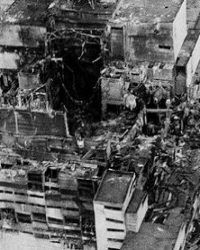 From Chernobyl Town we drive past numerous abandoned settlements to a place known as “The Vehicle Cemetry.” Though Yuri has been talking about it for the last ten minutes, no amount of words can prepare us for the sight that greets us as we emerge from a dark pine forest. In a huge field, parked next to each other in neat rows stretching for hundreds of yards, are hundreds of rusting fire engines, armoured cars, lorries, coaches, cars and jeeps. Rendered highly radioactive due to their proximity to the fire, they have sat here untouched for eighteen years. The only word we can utter is “wow!” From the roadside the geiger counter measures around 60 microroentgens and Yuri advises we go no further. In the middle of this vast sea of vehicles, rotor blades drooping mournfully to the ground, sit six huge Russian army helicopters now home to hundreds of swallows. It was in these very helicopters that military pilots braved extreme heat and massive doses of radiation to drop some 5,000 tonnes of Boron, dolomite, clay and lead on the gaping reactor. Needless to say many gave their lives doing so. With the fire out and radiation release contained, tens of thousands of workers were then shipped in to work day and night constructing the “Sarcophagus”. Using 400,000 cubic metres of concrete and 7,000 tons of metal they encased Reactor Four and 200 tons of hazardous materials in a protective tomb that remains there to this day – and tomb it is for the bodies of the two reactor crew killed in the blast were never found.
From Chernobyl Town we drive past numerous abandoned settlements to a place known as “The Vehicle Cemetry.” Though Yuri has been talking about it for the last ten minutes, no amount of words can prepare us for the sight that greets us as we emerge from a dark pine forest. In a huge field, parked next to each other in neat rows stretching for hundreds of yards, are hundreds of rusting fire engines, armoured cars, lorries, coaches, cars and jeeps. Rendered highly radioactive due to their proximity to the fire, they have sat here untouched for eighteen years. The only word we can utter is “wow!” From the roadside the geiger counter measures around 60 microroentgens and Yuri advises we go no further. In the middle of this vast sea of vehicles, rotor blades drooping mournfully to the ground, sit six huge Russian army helicopters now home to hundreds of swallows. It was in these very helicopters that military pilots braved extreme heat and massive doses of radiation to drop some 5,000 tonnes of Boron, dolomite, clay and lead on the gaping reactor. Needless to say many gave their lives doing so. With the fire out and radiation release contained, tens of thousands of workers were then shipped in to work day and night constructing the “Sarcophagus”. Using 400,000 cubic metres of concrete and 7,000 tons of metal they encased Reactor Four and 200 tons of hazardous materials in a protective tomb that remains there to this day – and tomb it is for the bodies of the two reactor crew killed in the blast were never found.From there we drive across a bridge over the Pripyat river, past the rusting hulks of abandoned tankers that remain floating to this day to the village of Paryshev some 20 kms from the Power Plant. In 1986 some 500 people lived here. Now it’s home to one. Tolerated by the authorities as an oddity. Maria Shylan is 75, stands not much over four foot and is the toughest, feistiest, most energetic grandmother you could ever hope to meet. She welcomes us warmly into her cottage and immediately open a bottle of her homemade Apricot moonshine. “Wow!” again. In her sitting room she proudly shows us photos of her grandchildren but her voice cracks as she points out their father, her son. Formerly a crane driver at the power plant, she explains, he died at the age of 48 from cancer some four months ago.
“I came back a year after the evacuation,” she tells us, “there weren’t any checkpoints back then. This is my motherland, it’s where I belong, I’m happy here regardless of these risks they talk of.” After another shot of moonshine, I tuck into tomatoes from her garden and even a raw hen’s egg – a traditional Ukrainian peasant snack. It’s only as we’re leaving that Anto tells me what Alexandra …..head of Chernobyl’s nuclear safety had told him whilst I was buying a round the previous afternoon: “It’s up to you but I would never eat anything from inside the exclusion zone.”
We head back over the Pripyat river towards the City of Pripyat itself. Having crossed a deserted railway line complete with sleeping trains we pass through another armed checkpoint before finally heading down “Lenin Avenue”. On either side we glimpse white buildings barely visible through undergrowth that has flourished unchecked for eighteen years. Emerging in the central square we park the car in the middle of the road. The first things that strike you are the silence, the stillness and the decay – years of conditioning have taught us that city centres are noisy, bustling and neat. Pripyat is none of these. Opposite us stands the city’s only hotel it’s name written large in peeling letters across the top, next to that is the social centre and concert venue and next to that a government building complete with the Soviet Hammer and Sickle. This is the closest you can get to time travel – we are standing in a Soviet city, fully fifteen years after the Soviet Union ceased to exist.
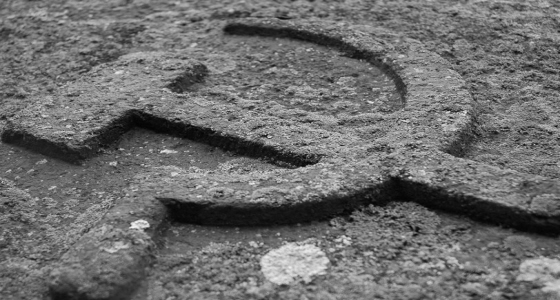
The day before at the Chernobyl Museum in Kiev Anto and I had watched a film made in Pripyat’s city centre the day after the explosion. Heavily flecked by the bombardment of radiation on the celluloid, it showed mothers pushing, prams, people waiting at bus stops and business as usual in Pripyat. None of them knew because none were told that they were quietly absorbing massive doses of radiation - including the cameraman. “He died shortly after filming that,” says Yuri nodding sadly.
“Drink anyone?” counters Timur producing a bottle of red and some camembert. As cheese and wine parties go this is not the liveliest ever but the venue takes some beating. Yuri leads us around the corner into a smaller square surrounded by eight story tower blocks on all sides. Amongst the dense vegetation in the middle Anto points out the ghostly frames of a child’s slide and swing. We climb, through open doors and up dusty stairwells lined with peeling paint, stopping occasionally to peer into flats hurriedly vacated by their owners on the promise that they would be allowed to return in three days.
Alexandra …..The head Of Nuclear Safety’s wife Elena had been brought up in Pripyat and was seventeen at the time of the tragedy: “I was lucky because I was staying far away with friends when it happened,” she recalled when we spoke to her the day before, “then when I came back two days later many people were heading to the train station and roadsweepers were washing the streets. The local radio station said stay home, close all windows, don’t drink the water and get ready to leave in buses.”
Had she, I wondered, ever returned to her family’s flat in Pripyat? “Yes, Alexandra took me in back 1992,” she replied visibly upset, “but never again. The front door was open and all our furniture and clothes were gone. I remembered Pripyat as a clean and beautiful city but it was deserted and the plants were taking over the city. I cried for three days afterwards.” Heaven knows what she’d think of the place today.
Above us from the top floor flat Anto and I hear an eerie tune filtering down the stairwell. We investigate and discover Yuri playing a piano eighteen years out of tune. “There it is,” he says pointing through the grimy window and there, 3kms in the distance, we catch our first sight of the Power Station. On the floor amongst the dust I find some black and white photographs – amazingly, they show children in school staring directly at the camera. It is difficult not to discern some sort of accusation in their solemn staring faces.
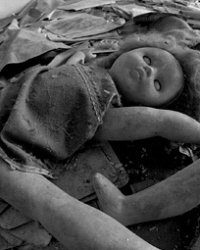 Perhaps the saddest thing about the Chernobyl tragedy is that because cells that multiply rapidly are most vulnerable to the effects of radiation, children are hit particularly hard. In the days after the explosion it’s thought that up to a million children in Ukraine, and neighbouring Belarus were exposed to critical doses of radiation one thousand times that of normal.
Perhaps the saddest thing about the Chernobyl tragedy is that because cells that multiply rapidly are most vulnerable to the effects of radiation, children are hit particularly hard. In the days after the explosion it’s thought that up to a million children in Ukraine, and neighbouring Belarus were exposed to critical doses of radiation one thousand times that of normal. “I’ve seen a really high increase in incidence of cancer among those who were young at the time of the accident,” Dr Pavlo Zamostyan one of Ukraine’s leading medical experts on radiation, told us over lunch, “Particularly dangerous was the radioctive iodine which was absorbed by children’s thyroid glands in the first two months.” Add to that the longer lasting radioactive Caesium which is still being absorbed via water, milk, mushrooms and root vegetables and it’s no wonder that low immune systems, gastric imflammation, cataracts, aggressive cancers and death continue to visit thousands of the children of Chernobyl. The longer term consequences of damaged DNA to future generations are not known - genetic deformities, mutations and abnormalities have yet to rear their ugly heads.
We walk behind the hotel to the Pripyat’s fairground where the dodgems sit rotting where the last customers left them. “Er…please no standing there!” yells Yuri as I gaze at them, mesmerized by the decay. “Moss is not good to stand on – look.” The Geiger Counter registers 140 microroentgens when he lays it on the tarmac but when he puts it on the moss, it clicks like an excited dolphin leaping up rapidly to 1200. “Moss absorb the radiation,” he grins.
Most moving and grimly fascinating of all the sights in Pripyat is the Big Wheel that never turned. It is odd that something built to give joy and excitement, is now capable of inspiring only sadness and reflection. “So now we visit the reactor itself!” exclaims Yuri. “How close in kilometres are we allowed to get to it?” asks Anto, worried that he should have brought his zoom lens. “Oh let me see,” says Yuri grinning, “maybe 150 metres.” As we pass forests of pylons, electrical conductors and numerous cranes frozen statue-like against the clear blue sky, the geiger counter clicks along at 111 roentgens rising steadily to 300 as we drive alongside the cooling channel that snakes past reactors one and two. As we round a corner past Reactor Three the car falls silent as, beneath the striped cooling tower, the awesome sight of the “Sarcophagus” suddenly looms into view some 400 metres away. With the geiger counter now climbing towards 500 we press onwards, parking up and hurrying inside a building a mere 150 metres from the west wall of Reactor Four. Upstairs is a small room with leaflets, wallcharts, scale models and a large window affording an amazing view across acres of razor wire to the Sarcophagus.
Over lunch in Kiev two days before the trip I had asked Dr Pavlo Zamostyan one of Ukraine’s leading medical radiation experts if he thought the Sarcophagus was safe. “It’s temporary,” he had replied after a big intake of breath, “it was built under extreme conditions and built to last maybe ten years.” “But this is eighteen years later!” Anto blurted. “I know,” he shrugged.
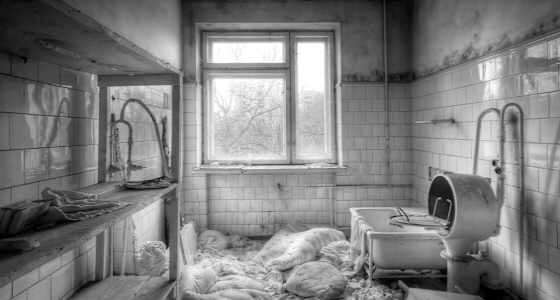
A day later I had put the same question to the head of Nuclear Safety for Chernobyl - the very man charged with the Sarcophagus’ safety: “That’s a difficult question,” he had replied after another worryingly long pause, “but it’s doing its job right now. Other countries have promised to help us with it but it hasn’t materialised. Look, my office is only 200 metres away and I find myself thinking: “What if it falls?” I wish I could go to sleep at night without thinking what’s going to happen this year and without being woken up by these scary thoughts.”
Using one of the models Yuri points out how the Sarcophagus is becoming “ever more dangerous – there are a lot of cracks, unstable places. It’s not waterproof we have to pump out over 2,000 cubic meters of radioactive water a year.”
As if I need more convincing I then pick up a booklet entitled “Shelter Transformation Safety” which details a report by a consortium of foreign construction companies made in 1995: “The existing shelter is unstable and…emergency measures must be taken.” It goes on to detail how hasty construction, shifting foundations and cracks have led the Sarcophagos to shift by 1.5 metres in places.” “Yuri,” I say showing him the booklet, “this was nine years ago – what’s been done since?” “Well plans are underway to build Sarcophagos 2,” he says showing me an illustration of a huge concrete arch encasing the old sarcophagos, “construction was scheduled to start in 2007 but now it looks more like like perhaps 2009…”
The feeling you get when staring at Chernobyl’s Sarcohphagus from 150metres away is, I imagine, much like the feeling you’d get if you crawled to the edge of an active volcano and peered inside. You’re scared and you hope – because that’s all you can do. When man first split the atom, many feared that mankind had crossed the Rubicon – that he had unleashed an ungodly power, an evil genie that could never be squeezed back into the bottle. That when you mess around with the very building blocks of life there is every chance that they may turn around and mess with you. They were right.It seems likely that even more dangerous to the world today than the threat of terrorism is the reality of international apathy. Government’s can do more than hope - they can take action. If they don’t, we face the frightening possibility that the next Chernobyl may well take place at Chernobyl.
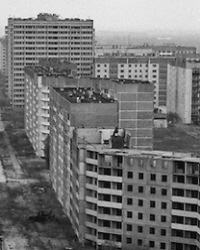 Countdown to disaster
Countdown to disaster25th April 1986: Friday evening
Despite the fact that this typre of reactor is known to be unstable at low power settings, the crew at Chernobyl’s reactor 4 begin preparing for a routine test to determine how long its turbines will spin and supply electricity once the reactor is shut down.
Automatic shutdown systems are unwisely disabled along with emergency cooling systems.
26th April 1986: Saturday morning
1:03am
The reactor is switched to low power mode but pockets of steam soon develop diminishing the crucial flow of coolant water and resulting in a steady increase in power output.
1:23:00am
The director, noticing the power increase, decides to shutdown the reactor completely.
The domino effect of previous errors is compounded by a peculiarity of design which results in a catastrophic five second surge in power.
The fuel elements rupture causing a massive amounts of water to become superheated and steam to build up
1:23:49 secs
The pressure reaches critical point blowing the 3,000 ton plate covering the reactor to smithereens.
A second explosion spews out chunks of burning nuclear fuel and graphite from the reactor’s core 1km into the night sky. Air rushes in causing the graphite insulating blocks to burst into flames.
The fire rages for ten days before finally being extinguished.
Used by Kind Permission
Originally Appeared in FHM April 2006



